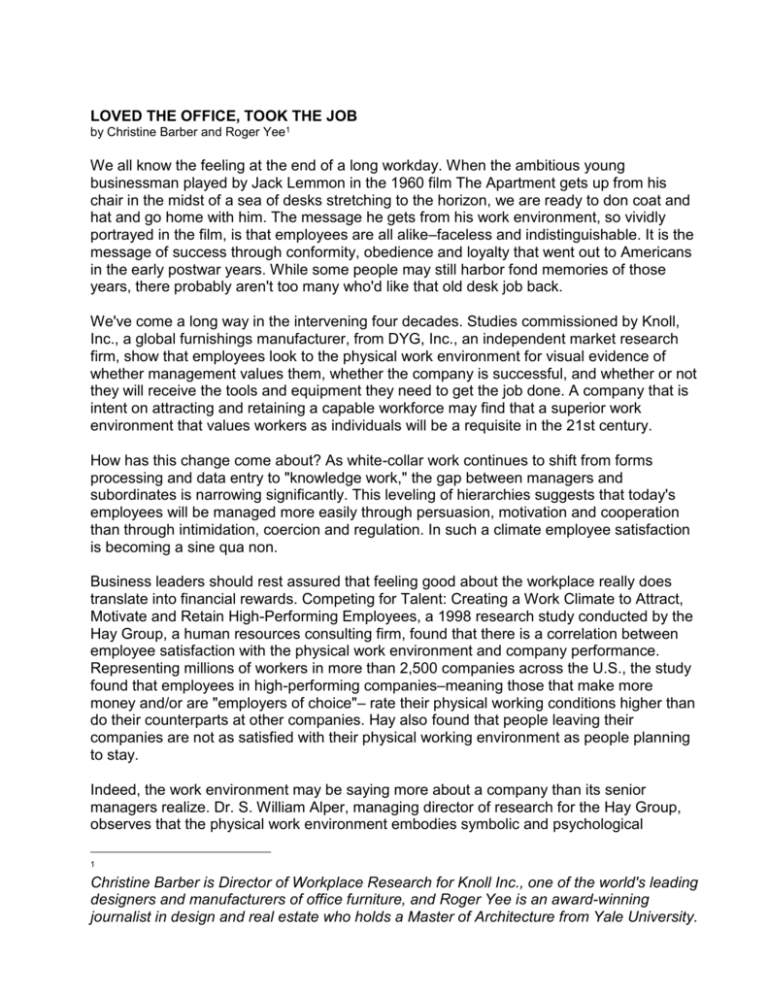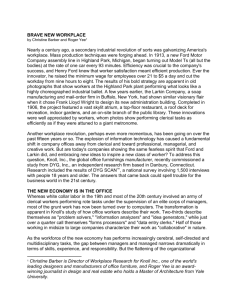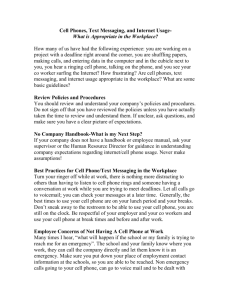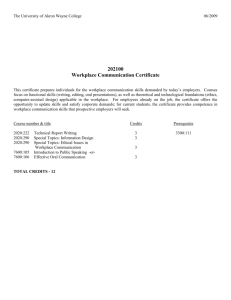LOVED THE OFFICE, TOOK THE JOB by Christine Barber and
advertisement

LOVED THE OFFICE, TOOK THE JOB by Christine Barber and Roger Yee1 We all know the feeling at the end of a long workday. When the ambitious young businessman played by Jack Lemmon in the 1960 film The Apartment gets up from his chair in the midst of a sea of desks stretching to the horizon, we are ready to don coat and hat and go home with him. The message he gets from his work environment, so vividly portrayed in the film, is that employees are all alike–faceless and indistinguishable. It is the message of success through conformity, obedience and loyalty that went out to Americans in the early postwar years. While some people may still harbor fond memories of those years, there probably aren't too many who'd like that old desk job back. We've come a long way in the intervening four decades. Studies commissioned by Knoll, Inc., a global furnishings manufacturer, from DYG, Inc., an independent market research firm, show that employees look to the physical work environment for visual evidence of whether management values them, whether the company is successful, and whether or not they will receive the tools and equipment they need to get the job done. A company that is intent on attracting and retaining a capable workforce may find that a superior work environment that values workers as individuals will be a requisite in the 21st century. How has this change come about? As white-collar work continues to shift from forms processing and data entry to "knowledge work," the gap between managers and subordinates is narrowing significantly. This leveling of hierarchies suggests that today's employees will be managed more easily through persuasion, motivation and cooperation than through intimidation, coercion and regulation. In such a climate employee satisfaction is becoming a sine qua non. Business leaders should rest assured that feeling good about the workplace really does translate into financial rewards. Competing for Talent: Creating a Work Climate to Attract, Motivate and Retain High-Performing Employees, a 1998 research study conducted by the Hay Group, a human resources consulting firm, found that there is a correlation between employee satisfaction with the physical work environment and company performance. Representing millions of workers in more than 2,500 companies across the U.S., the study found that employees in high-performing companies–meaning those that make more money and/or are "employers of choice"– rate their physical working conditions higher than do their counterparts at other companies. Hay also found that people leaving their companies are not as satisfied with their physical working environment as people planning to stay. Indeed, the work environment may be saying more about a company than its senior managers realize. Dr. S. William Alper, managing director of research for the Hay Group, observes that the physical work environment embodies symbolic and psychological 1 Christine Barber is Director of Workplace Research for Knoll Inc., one of the world's leading designers and manufacturers of office furniture, and Roger Yee is an award-winning journalist in design and real estate who holds a Master of Architecture from Yale University. messages about cultural aspects of an organization as well as economic ones: Does it support collaboration and open communication? Is it hierarchical? Does it create social distance between layers and departments? Is it flexible and innovative versus static/status quo--oriented? "The expression of culture in the workplace is gaining importance to companies," Alper cautions, "since there is tremendous focus on issues such as teamwork, customer satisfaction and employee empowerment." Hence, the business world's growing interest in creating "happy employees" to affect the bottom line goes well beyond sentimentality. Consider what happened when consulting firm Watson Wyatt's WorkUSA 2000 survey asked more than 7,500 American workers what they thought about their jobs and their companies. The consultants used workers' answers to calculate employee commitment, and then examined how the companies' shareholders had done over a three-year period. The closeness of the relationship is startling. Whereas companies with low commitment levels from their employees had a three-year return to shareholders of 76 percent, companies that exhibited the highest rate of happy workers had a shareholder return of 112 percent. The committed workers described their companies as "employers of choice"–places they wouldn't leave for a comparable salary elsewhere. IT'S NOT JUST THE MONEY In today's battle for top talent, senior management has to offer more than high pay to win employees' trust. There is no doubt that workers' attitudes toward their employers and the workplace have changed. There is ample evidence that employee loyalty is at an all-time low and that workers now focus on maintaining a portable-skill set so they can move from opportunity to opportunity, rather than making a 30-year commitment. Further, newer entrants to the workforce are pushing employers to blur the boundaries between work and personal life in an effort to strike a better balance in their lives. But Knoll's research suggests that achieving such equilibrium is difficult. Three-fourths of office workers report that they often do not have enough time in the day to do what they need to do, and twothirds identify the growing demands of business, with pressures to perform better and faster, as a major source of their burden. Not surprisingly, business is rapidly losing respect. DYG's SCAN™, a syndicated research-based consulting program, shows that 61 percent of respondents accuse companies of focusing too much on profits at the expense of employees and customers. What companies have done in the name of reengineering, downsizing or outsourcing has not exactly bolstered employees' confidence in business. Getting employers to respond to the needs and aspirations of a better educated, more highly skilled– but heavily stressed–workforce requires a major change in corporate culture. A growing number of employers are taking the bottom-line benefit of worker commitment very seriously because fewer qualified workers are entering the workforce. As the cost of employee turnover increases, recruiting and retaining has become the new corporate mantra. The Saratoga Institute, a human resources think tank, has devised a formula estimating the cost of replacing one worker to be about one-and-a- half times that worker's salary. High-tech talent is so scarce that some firms report spending as much as $150,000 to find just one qualified worker. IS THERE A "HAPPY WORK ENVIRONMENT"? Many senior managers may still be unaware that the physical work environment plays such a key role. They should take note: Twenty-five years' worth of research by the Gallup Organization, as presented by Marcus Buckingham and Curt Coffman in their illuminating 1999 book First Break All the Rules, points to two key indicators that measure the strength of a workplace: 1) Do workers know what is expected of them at work? and 2) Do workers have the materials and equipment (including the office) they need to do their work right? What years of findings confirm is that the office, along with the tools and equipment that workers are given, is a major component of what Gallup refers to as "base camp," where the key to building a strong, vibrant workplace resides. More than a million employees are saying that they simply want the means to do their jobs properly. The office is a vital part of the tool kit. The physical workplace can also be a red or green flag to potential employees. Knoll's study The Second Bottom Line: Competing for Talent Using Innovative Workplace Design reports that the physical environment is one of the first impressions a prospective worker has of a company, and it speaks volumes. Ideally, the workplace should manifest the high regard a company has for its workforce. By contrast, workers say that a workplace that has not been well thought out or maintained sends out many negative messages: "Management doesn't care about us," or, "Management is cheap." Worse yet, the space may actually be communicating, "The company isn't doing well. Don't bother working here!" Obviously, the physical environment evolves in tandem with a company's overall philosophy regarding its employees. A progressive 21st-century organization will instill its employment philosophy in all key areas of human resource management. Dan Yankelovich, chairman of DYG, predicts, "Businesses will increasingly pursue a second bottom line that has to do with attention to the needs of employees and customers as well as shareholders..., not as a return to the 1970s idea of social responsibility, but as good business–an improved second bottom line (happy employees and customers) contributes to a healthy first bottom line, profit." Yet the new emphasis on the planning and design of the physical work environment does not call for drowning the office in trivial ornamentation. According to Martha O'Mara, author of the recent book Strategy and Place, a company's goals, values and image are communicated by its physical environment. Further, the design of the space can encourage certain behaviors while making symbolic statements about who the company is. O'Mara has comprehensively documented the role of physical space in achieving a multitude of business strategies. One example involves the high-tech firm G-Tech. The company's CEO and cofounder staunchly defended the use of style in the development of the company's corporate headquarters by asserting, "Style is the most important strategic resource to manage. Style is the manner in which a company states its culture." Other companies believe that better-quality facilities can even give them an advantage over competitors by sending powerful signals to the marketplace. DaimlerChrysler, for example, often features its Auburn Hills, Michigan, technology center in its advertisements and openly discusses how its facilities help the company accelerate innovative product development. PRODUCTIVITY AND SATISFACTION FROM DESIGN? What employees want need not be a mystery to an employer. Just asking can reveal a wealth of information. Knoll's national survey of 350 office workers asked them to identify those physical workspace characteristics that would make them more productive and those that would make them more satisfied. The responses showed that the greatest gain in productivity, cited by more than 70 percent of workers, would come from having state-ofthe-art technology, storage space for work-related items, the ability to control climate, quiet space, and space that can be personalized to the occupant's work style. Of moderate impact, named by 50-60 percent, were an ergonomic chair, a visually appealing workspace, lighting control, privacy, and an exterior window. Least significant were a large workspace, personal space for small meetings, and space for personal items. Responses for satisfaction mirrored those for productivity. This is valuable information for employers in an expanding economy with a tight labor market, where satisfaction in the workplace is an increasingly important incentive. There is no magic formula for the ideal work environment– each organization and each workforce is unique in its requirements. But companies must pay attention to improving the workplace if they want to attract and retain the employees they want. According to Alper, "Traditional workplaces are suffering in their ability to recruit. Prospective employees complain that they are too stodgy, the jobs are not challenging enough, workers have no stake in the business, and people cannot move up quickly enough." In the current gestalt, what they're really saying is that these companies are doing too little to satisfy their workforce. Companies and senior managers are being pushed to loosen up. Will they? Coming to grips with change could ensure their very survival in the new century–and put smiles on the faces of employees, customers, and shareholders alike.








